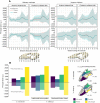Comparative cranial biomechanics in two lizard species: impact of variation in cranial design
- PMID: 33504585
- PMCID: PMC7970069
- DOI: 10.1242/jeb.234831
Comparative cranial biomechanics in two lizard species: impact of variation in cranial design
Abstract
Cranial morphology in lepidosaurs is highly disparate and characterised by the frequent loss or reduction of bony elements. In varanids and geckos, the loss of the postorbital bar is associated with changes in skull shape, but the mechanical principles underlying this variation remain poorly understood. Here, we sought to determine how the overall cranial architecture and the presence of the postorbital bar relate to the loading and deformation of the cranial bones during biting in lepidosaurs. Using computer-based simulation techniques, we compared cranial biomechanics in the varanid Varanus niloticus and the teiid Salvator merianae, two large, active foragers. The overall strain magnitude and distribution across the cranium were similar in the two species, despite lower strain gradients in V. niloticus In S. merianae, the postorbital bar is important for resistance of the cranium to feeding loads. The postorbital ligament, which in varanids partially replaces the postorbital bar, does not affect bone strain. Our results suggest that the reduction of the postorbital bar impaired neither biting performance nor the structural resistance of the cranium to feeding loads in V. niloticus Differences in bone strain between the two species might reflect demands imposed by feeding and non-feeding functions on cranial shape. Beyond variation in cranial bone strain related to species-specific morphological differences, our results reveal that similar mechanical behaviour is shared by lizards with distinct cranial shapes. Contrary to the situation in mammals, the morphology of the circumorbital region, calvaria and palate appears to be important for withstanding high feeding loads in these lizards.
Keywords: Feeding; Finite element analysis; Lepidosauria; Multibody dynamic analysis; Skull; Squamata.
© 2021. Published by The Company of Biologists Ltd.
Conflict of interest statement
Competing interestsThe authors declare no competing or financial interests.
Figures






Similar articles
-
Bite force and cranial bone strain in four species of lizards.J Exp Biol. 2018 Dec 4;221(Pt 23):jeb180240. doi: 10.1242/jeb.180240. J Exp Biol. 2018. PMID: 30352826
-
The relationship between cranial structure, biomechanical performance and ecological diversity in varanoid lizards.PLoS One. 2015 Jun 24;10(6):e0130625. doi: 10.1371/journal.pone.0130625. eCollection 2015. PLoS One. 2015. PMID: 26106889 Free PMC article.
-
Functional implications of dicynodont cranial suture morphology.J Morphol. 2010 Jun;271(6):705-28. doi: 10.1002/jmor.10828. J Morphol. 2010. PMID: 20077504
-
Toward Understanding the Mammalian Zygoma: Insights From Comparative Anatomy, Growth and Development, and Morphometric Analysis.Anat Rec (Hoboken). 2017 Jan;300(1):76-151. doi: 10.1002/ar.23485. Anat Rec (Hoboken). 2017. PMID: 28000398 Review.
-
The role of cranial kinesis in birds.Comp Biochem Physiol A Mol Integr Physiol. 2001 Dec;131(1):197-205. doi: 10.1016/s1095-6433(01)00470-6. Comp Biochem Physiol A Mol Integr Physiol. 2001. PMID: 11733177 Review.
Cited by
-
True colours or red herrings?: colour maps for finite-element analysis in palaeontological studies to enhance interpretation and accessibility.R Soc Open Sci. 2021 Nov 17;8(11):211357. doi: 10.1098/rsos.211357. eCollection 2021 Nov. R Soc Open Sci. 2021. PMID: 34804580 Free PMC article.
-
Comparative Cranial Joint Variation in Three Different Lizards: Impact of Feeding Habit.Life (Basel). 2025 Jan 13;15(1):90. doi: 10.3390/life15010090. Life (Basel). 2025. PMID: 39860030 Free PMC article.
-
Comparison of diverse mandibular mechanics during biting in Devonian lungfishes.iScience. 2025 Jun 21;28(7):112970. doi: 10.1016/j.isci.2025.112970. eCollection 2025 Jul 18. iScience. 2025. PMID: 40687803 Free PMC article.
-
Assessment of the mechanical role of cranial sutures in the mammalian skull: Computational biomechanical modelling of the rat skull.J Morphol. 2023 Mar;284(3):e21555. doi: 10.1002/jmor.21555. J Morphol. 2023. PMID: 36630615 Free PMC article.
-
Modeling tooth enamel in FEA comparisons of skulls: Comparing common simplifications with biologically realistic models.iScience. 2021 Sep 28;24(11):103182. doi: 10.1016/j.isci.2021.103182. eCollection 2021 Nov 19. iScience. 2021. PMID: 34761178 Free PMC article.
References
-
- Ahrens, J., Geveci, B. and Law, C. (2005). ParaView: an end-user tool for large-data visualization. In Visualization Handbook (ed. Johnson C. R.), pp. 717-731. Burlington, USA: Butterworth-Heinemann.
-
- Burbrink, F. T., Grazziotin, F. G., Pyron, R. A., Cundall, D., Donnellan, S., Irish, F., Keogh, J. S., Kraus, F., Murphy, R. W., Noonan, B.et al. (2020). Interrogating genomic-scale data for Squamata (lizards, snakes, and amphisbaenians) shows no support for key traditional morphological relationships. Syst. Biol. 69, 502-520. 10.1093/sysbio/syz062 - DOI - PubMed
-
- Cartmill, M. (1980). Morphology, function, and evolution of the anthropoid postorbital septum. In Evolutionary Biology of the New World Monkeys and Continental Drift (ed. Ciochon R. L. and Chiarelli A. B.), pp. 243-274. Boston, USA: Springer US.
Publication types
MeSH terms
Grants and funding
- BB/M010287/1/BB_/Biotechnology and Biological Sciences Research Council/United Kingdom
- BB/H011854/1/BB_/Biotechnology and Biological Sciences Research Council/United Kingdom
- BB/H011668/1/BB_/Biotechnology and Biological Sciences Research Council/United Kingdom
- BB/M008061/1/BB_/Biotechnology and Biological Sciences Research Council/United Kingdom
- BB/M008525/1/BB_/Biotechnology and Biological Sciences Research Council/United Kingdom
LinkOut - more resources
Full Text Sources
Other Literature Sources

